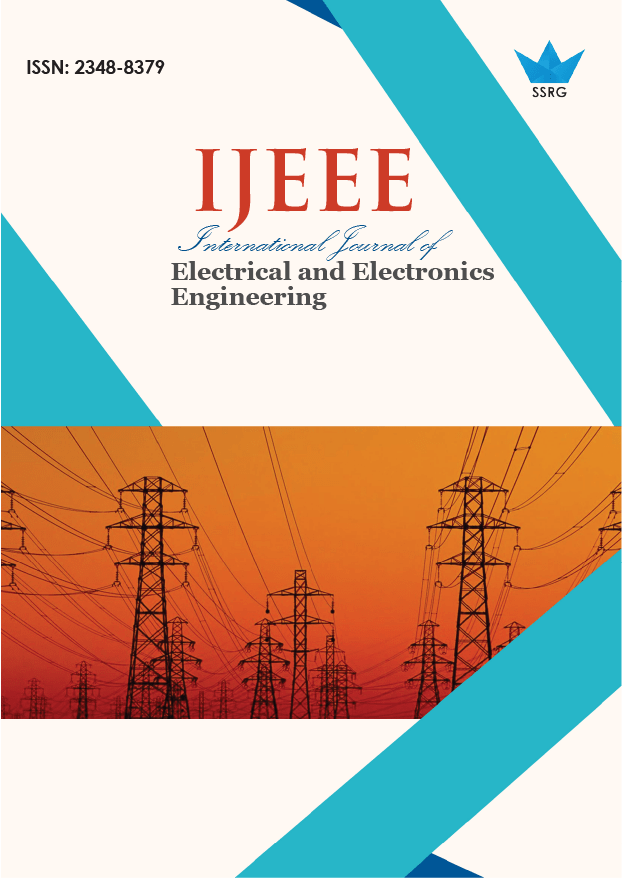Predicting Transient Stability of Power Systems Using Machine Learning: A Case Study on the IEEE New England 39-Bus Test System

| International Journal of Electrical and Electronics Engineering |
| © 2024 by SSRG - IJEEE Journal |
| Volume 11 Issue 8 |
| Year of Publication : 2024 |
| Authors : Diaa Salman, Yonis Khalif Elmi, Abdulaziz Ahmed Siyad, Abdirahman Abdullahi Ali |
How to Cite?
Diaa Salman, Yonis Khalif Elmi, Abdulaziz Ahmed Siyad, Abdirahman Abdullahi Ali, "Predicting Transient Stability of Power Systems Using Machine Learning: A Case Study on the IEEE New England 39-Bus Test System," SSRG International Journal of Electrical and Electronics Engineering, vol. 11, no. 8, pp. 236-247, 2024. Crossref, https://doi.org/10.14445/23488379/IJEEE-V11I8P121
Abstract:
The need to evaluate the transient stability of power systems is inevitable and crucial in order to ensure that they will continue to operate efficiently after interruptions. In the present investigation, an attempt is made to use machine learning methods, particularly the XGBoost and the Random Forest models, with the objective of predicting the stability of the power systems after a fault has occurred. Thus, the dataset used by the models has several generator and bus parameters, as well as pre and post-fault conditions; the objective is to identify if the system stability is stable or unstable. In general, it is possible to conclude that the use of a hybrid model, combining the XGBoost and Random Forest techniques, outperforms each model separately. This is the case because it has the merits of both methods as it combines the two methods to identify the similarities of the two plans. In this case, the effectiveness of the proposed approach is assessed using evaluation parameters like accuracy, precision, recall rate, and F1-score. Furthermore, the study gives an understanding of the stability measures most affected by the characteristics and those that affect stability predictions. By applying more complex modes of predictive modeling, this work contributes to advancing the reliability and efficacy of power grid management.
Keywords:
Transient stability, Machine learning, Power systems, XGBoost, Random Forest.
References:
[1] Shitu Zhang, Zhixun Zhu, and Yang Li, “A Critical Review of Data-Driven Transient Stability Assessment of Power Systems: Principles, Prospects and Challenges,” Energies, vol. 14, no. 21, 2021.
[CrossRef] [Google Scholar] [Publisher Link]
[2] Petar Sarajcev et al., “Artificial Intelligence Techniques for Power System Transient Stability Assessment,” Energies, vol. 15, no. 2, 2022.
[CrossRef] [Google Scholar] [Publisher Link]
[3] Minghua Chen et al., “XGBoost-Based Algorithm Interpretation and Application on Post-Fault Transient Stability Status Prediction of Power System,” IEEE Access, vol. 7, pp. 13149-13158, 2019.
[CrossRef] [Google Scholar] [Publisher Link]
[4] Mihail Senyuk et al., “Power System Transient Stability Assessment Based on Machine Learning Algorithms and Grid Topology,” Mathematics, vol. 11, no. 3, 2023.
[CrossRef] [Google Scholar] [Publisher Link]
[5] Jun Liu et al., “An Improved Power System Transient Stability Prediction Model Based on mRMR Feature Selection and WTA Ensemble Learning,” Applied Sciences, vol. 10, no. 7, 2020.
[CrossRef] [Google Scholar] [Publisher Link]
[6] Paul Andrew Vlahutin, “Power System Transient Stability Assessment by Pattern Recognition,” Dissertations & Theses, Western Reserve University, 1971.
[Google Scholar]
[7] Yanzhen Zhou et al., “A Hierarchical Method for Transient Stability Prediction of Power Systems Using the Confidence of a SVM-Based Ensemble Classifier,” Energies, vol. 9, no. 10, 2016.
[CrossRef] [Google Scholar] [Publisher Link]
[8] Luyu Ji et al., “Using Trajectory Clusters to Define the Most Relevant Features for Transient Stability Prediction Based on Machine Learning Method,” Energies, vol. 9, no. 11, 2016.
[CrossRef] [Google Scholar] [Publisher Link]
[9] Albert Poulose, and Soobae Kim, “Transient Stability Analysis and Enhancement Techniques of Renewable-Rich Power Grids,” Energies, vol. 16, no. 5, 2023.
[CrossRef] [Google Scholar] [Publisher Link]
[10] A. Kunac, and P. Sarajcev, “Ensemble Learning Approach to Power System Transient Stability Assessment,” 2020 5th International Conference on Smart and Sustainable Technologies (SpliTech), Split, Croatia, pp. 1-6, 2020.
[CrossRef] [Google Scholar] [Publisher Link]
[11] Yuqiong Zhang et al., “A Power System Transient Stability Assessment Method Based on Active Learning,” The Journal of Engineering, vol. 2021, no. 11, pp. 715-723, 2021.
[CrossRef] [Google Scholar] [Publisher Link]
[12] Qilin Wang, Chengzong Pang, and Hashim Alnami, “Transient Stability Prediction Based on Long Short-term Memory Network,” 2021 North American Power Symposium (NAPS), pp. 1-6, 2021.
[CrossRef] [Google Scholar] [Publisher Link]
[13] Ramraj Santhanam et al., “Experimenting XGBoost Algorithm for Prediction and Classification of Different Datasets Experimenting XGBoost Algorithm for Prediction and Classification of Different Datasets,” International Journal of Control Theory and Applications, vol. 9, no. 40, pp. 651-662, 2016.
[Google Scholar] [Publisher Link]
[14] Y. Wang et al., “A Hybrid Ensemble Method for Pulsar Candidate Classification,” Astrophysics and Space Science, vol. 364, 2019.
[CrossRef] [Google Scholar] [Publisher Link]
[15] Emil D. Attanasi, and Timothy C. Coburn, “Random Forest,” Encyclopedia of Mathematical Geosciences, pp. 1182-1185, 2023.
[CrossRef] [Google Scholar] [Publisher Link]
[16] Harmandeep Kaur, and Munish Kumar, “On the Recognition of Offline Handwritten Word Using Holistic Approach and AdaBoost Methodology,” Multimedia Tools and Applications, vol. 80, no. 7, pp. 11155-11175, 2021.
[CrossRef] [Google Scholar] [Publisher Link]
[17] Jabed Al Faysal et al., “XGB-RF: A Hybrid Machine Learning Approach for IoT Intrusion Detection,” Telecom, vol. 3, no. 1, pp. 52-69, 2022.
[CrossRef] [Google Scholar] [Publisher Link]
[18] Petar Sarajcev et al., IEEE New England 39-Bus Test Case: Dataset for the Transient Stability Assessment (2.0), Dataset, Zenodo, 2022. [Online]. Available: https://doi.org/10.5281/zenodo.7350829

 10.14445/23488379/IJEEE-V11I8P121
10.14445/23488379/IJEEE-V11I8P121